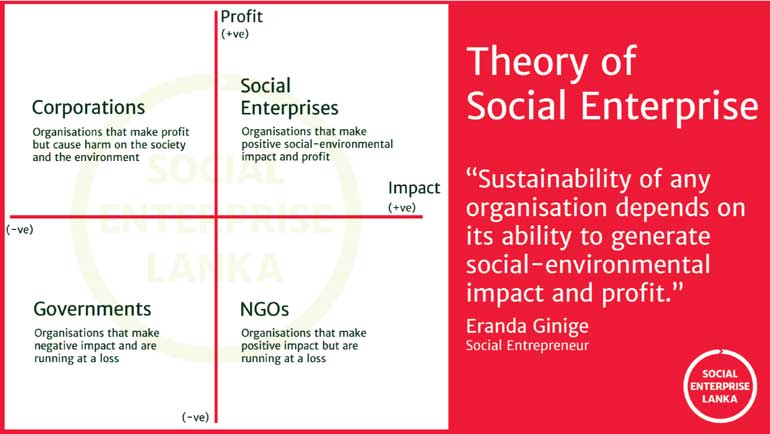Sunday Dec 21, 2025
Sunday Dec 21, 2025
Wednesday, 16 December 2015 00:00 - - {{hitsCtrl.values.hits}}

I remember the first time I learned about the concept of social entrepreneurship. It was a moment of revelation. It felt like somebody switched on a bright light inside my mind. A sense of perfect connection between purpose and practice. Finally, here is the middle way to prosperity, a path where we do not have to choose between wealth and value, economy and society, or development and environment. But I’ve realised not everybody understands it so easily. Some people have an inherent phobia towards anything ‘social’. Others are not ready to see beyond their comfort zones. That’s a good thing because it is the definitive evidence that social entrepreneurship is indeed a revolution.
I have written about the definition of social enterprise on Daily FT before. Simply put “social enterprises are self-sustaining entities with the core purpose of creating social and environmental impact.” I know that’s a broad stroke. There are stringent definitions in the global spectrum. But the purpose of this article is not to clarify the evolving definition of social enterprise. Instead, I would like to propose a simple theory to explain the ‘case’ for social enterprise.
Let me use a graph (fig 1) to explain this theory. The x-axis represents measured impact of an organisation on the society and environment. While there are several ways to measure the impact of an organisation, let’s assume such measurements are comparative and accurately weighed across sectors. The y-axis denotes net profit. So let’s now look at what type of organisations would fit into each of the four quadrants. (Note that I’m proposing profit as a function of impact).
Let’s start with quadrant II – here you’ll find organisations that make profit but cause more harm on the society and the environment through their products and processes. Most corporations and SMEs will fall into this quadrant.
Who do we have in quadrant III? The organisations that make negative impact and are running at a loss. You guessed right, most governments and government institutions, and inter-governmental organisations will fall into this quadrant.
And in quadrant IV, you’ll find the organisations that make positive impact but are running at a loss. In other words, they may be making positive changes in the society and the environment, but their expenditure is greater than their income. Most donor-funded organisations, traditional non-governmental organisations (NGOs), charities, community-based organisations (CBOs), civil-society organisations (CSOs) will fall into this quadrant.
And finally let’s look at quadrant I – here you’ll find organisations that make positive social-environmental impact as well as profit. Such organisations are called social enterprises.
Now you can think about where your organisation fits in within this framework. Let’s look at some examples. We do not have accurate and comparative measurements of the impact of organisations. But we can use our general understanding of organisations and their known impact. (I’m hesitant to suggest the idea of net-impact here for its obvious shortcomings.) We know too well what happens to a company which is purely driven by profit maximisation for its shareholders. The sin industries – oil, tobacco, alcohol, weapons manufacturers are obvious culprits. They make a lot of profit but they create far too many problems in the society and environment. Most multinational corporations are also in this quadrant. For example, the fertiliser companies may claim to produce food supply for the masses, but as a result of the abusive use of their tainted products, most agriculture-based countries are now at a far greater health and environmental risk due to soil and water pollution. Mobile phone companies brings us closer, but leave catastrophic trails of social-environmental problems from mining precious metals to increasing the risk of cancer through electromagnetic fields of their products. Apparel manufacturers generate huge profits and jobs but create far greater social and environmental problems along their supply chain. The list goes on.
Most governments are run at a loss. Their expenditure is greater than their revenue. By definition, governments are ultimately responsible for the social-environmental problems in their country. They keep on failing to solve those problems due to their short-term policies, corruption, wastage, bureaucracy, conflicting political interests, or simply because they don’t have the resources. We often see governments colluding with corporations for mutual gains, thus propagating negative impact. The Sri Lankan President recently said: “No matter how bad the situation is, the Government cannot control alcohol, tobacco and drugs, because the Government depends on them.” As naïve as it may sound, it is an honest reflection of the systemic failure of all governments around the world. This theory can be used to explain why governments have short lifespans.
Traditional NGOs are either dead or dying. For example, since the end of the war and Sri Lanka becoming a middle income country, the international donors simply stopped signing cheques for us. The once thriving NGO sector is now starving. But the social-environmental problems still exist, and are worsening. If nobody’s giving them money to cover their expenses, they are unable to function. Most have shrinking programs, some have shutdown altogether, and the serious ones are trying to find ways to become self-sustainable. After decades of conditioning to receive grants and assets freely, and without rigorous monitoring and evaluation, it is not easy for many of them to come out of that traditional, absurdly expensive charity mould. Another problem with the donor-funded model is the obligation to fulfil donors’ demands often at the expense of the social-environmental mission.
It is evident that all three groups above have failed and are unsustainable. They have proven their failure again and again to solve the world’s problems. The only type of organisations that seems to be able to sustain in the long run are the ones that create positive social impact as well as profit. We call them social enterprises (or social businesses). Organic producers, recycling companies, companies that are creating sustainable and equitable income sources for everybody, provide affordable education and health services for everybody, make innovative products that are biodegradable, toilets that reuse water, housing units that are completely self-contained, machines that produce low-cost sanitary napkins for women, are but a few examples of the fast growing global social enterprise sector.
So the next time someone asks you why “social enterprise”, draw this diagram and explain to them the case for social enterprise.
The writer is a social entrepreneur and the Founder of Social Enterprise Lanka. Please send your feedback to [email protected].